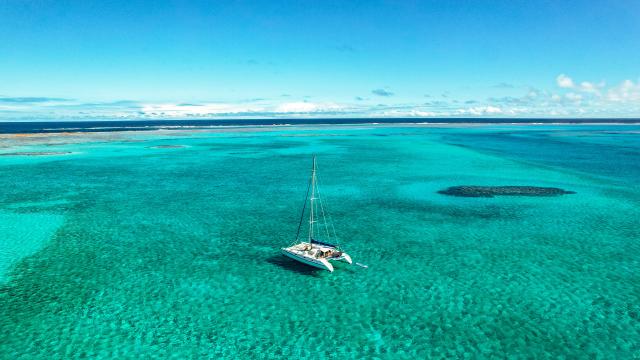 Catamaran cruise in New Caledonia
Catamaran cruise in New Caledonia Catamaran cruise in New Caledonia
Catamaran cruise in New Caledonia Sailing boat on the Isle of Pines
Sailing boat on the Isle of Pines Catamaran cruise in New Caledonia
Catamaran cruise in New Caledonia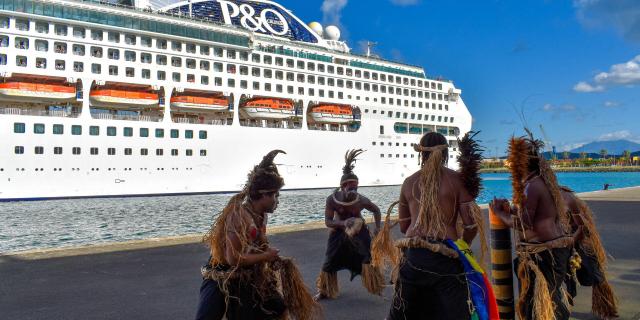 Dance for the reception of the cruise passengers in Noumea
Dance for the reception of the cruise passengers in NoumeaAround ten cruise lines, including industry leaders like Royal Caribbean Cruise and Carnival Cruise Lines from Australia and New Zealand, make stops in New Caledonia. Typically, these liners disembark passengers in Nouméa between 7 am and 9 am, setting sail again around 5 pm. This allows ample time to explore Nouméa, offering activities such as lagoon snorkelling, city and bay tours, visits to major museums, and various water sports. The cruise terminal (ferry terminal) conveniently welcomes passengers in downtown Nouméa on Jules Ferry Quay. Here, you’ll find tourist service providers and some shops. Tourist buses and taxis provide transportation in the capital, including to nearby beaches and islets.
As a vibrant South Pacific city, Nouméa offers a rewarding stopover experience. Yachtsmen should contact “Port Moselle” on VHF (Channel 67) or Port du Sud (24 47 77) for access to Nouméa. Upon arrival, each crew member must present a valid passport and visa, depending on nationality. Remember to display your yellow flag until all formalities are completed.
Capitainerie de Port Moselle : port.moselle@sodemo.nc – +687 27 71 97
Direction des douanes : douanes.nc@offatel.nc – +687 26 53 85
Police aux frontières : dpaf-noumea@interieur.gouv.fr – +687 24 32 00
Find the yacht arrival formalities form to hand to Sivap agents during inspection
Sivap : import-sivap.davar@gouv.nc – +687 78 26 81
Nouméa‘s two harbours, Port Moselle and Port du Sud, provide sanitary facilities, water, electricity, laundry, and a service station. Port Moselle offers free Wi-Fi. Nearby, you can dine at restaurants serving French and Caledonian cuisine, shop in malls, or enjoy various activities, including diving. Nouméa also hosts numerous boat repair, deck fitting, spare parts, and equipment suppliers. Transit boats enjoy tax exemptions on spare parts for repair work.
For more information, refer to the “Stopover guide”
 Catamaran in Port Moselle, Noumea
Catamaran in Port Moselle, Noumea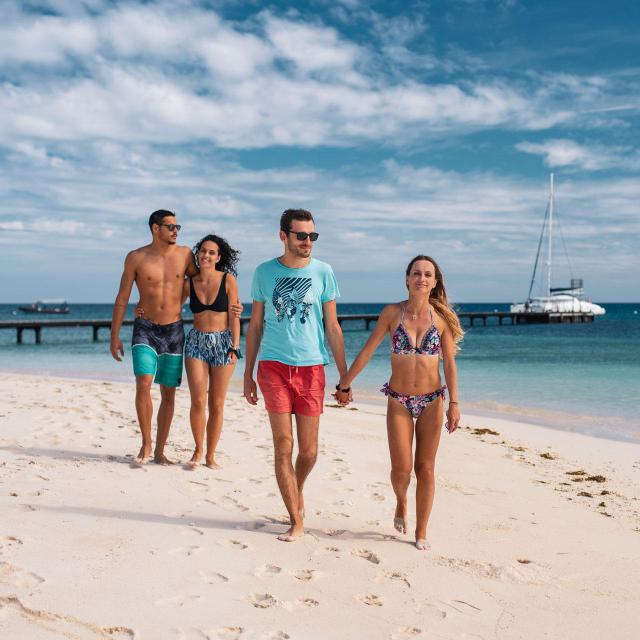 Outing on the Signal Island, Noumea
Outing on the Signal Island, NoumeaThe Southern Province offers 120 moorings in the marine protected areas around Nouméa. Islet Maître, Islet Signal, and Islet Larégnère feature beautiful beaches, barbecue spots, and snorkelling. When mooring, approach the buoys slowly, facing into the wind or current, and be cautious of swimmers and other boats. Check the condition of the mooring line you are using. Before departure, consult the tide times to avoid getting stranded on an islet.
Find out more:
Anchoring is only authorised in Kuto Bay. Before heading to Île des Pins, yachtsmen should contact the Gendarmerie and the Mairie de l’Île des Pins.
Gendarmerie de l’Île des Pins
Mairie de l’Île des Pins
 Boats at anchor on the Isle of Pines
Boats at anchor on the Isle of PinesAs part of a sustainable tourism initiative, a mooring area with connected buoys is now available in Kuto Bay on the Isle of Pines.
All you have to do is reserve a buoy on the Connect Kuto application to make mooring easier and more secure, and to benefit from additional services.
Sailing to the Loyalty Islands requires contacting Wé Marina on Lifou. All sailings to Ouvéa, Lifou, or Maré now require validation.
Wé Marina
If you wish to anchor outside the marina, please complete and send the anchorage application form below to the Marina de Wé 1 or 2 weeks before your departure.
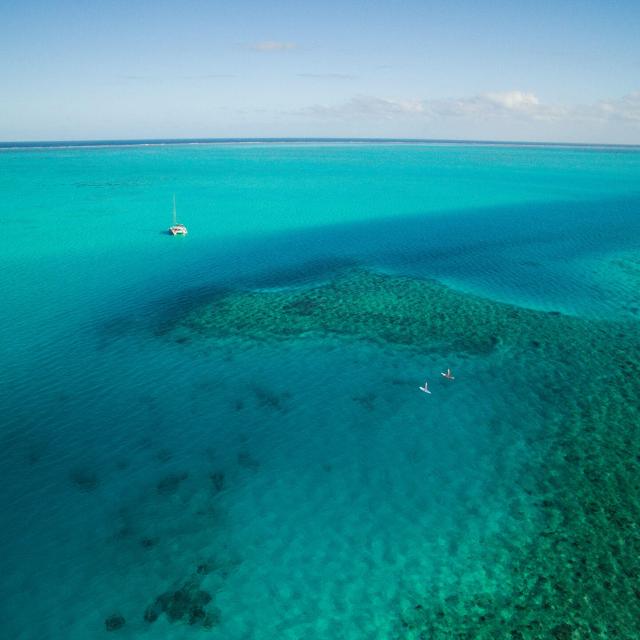 Catamaran on New Caledonia's turquoise lagoon
Catamaran on New Caledonia's turquoise lagoon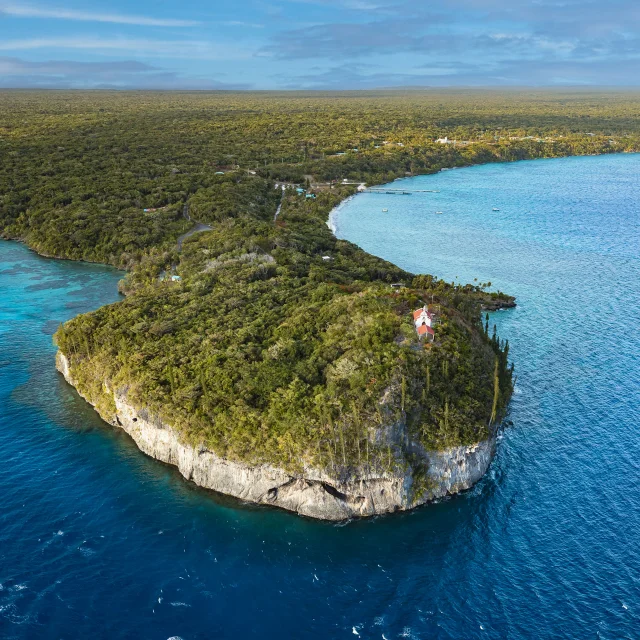 Jinek and Santal Bays in Lifou
Jinek and Santal Bays in LifouNumerous anchoring areas are available. Once on site, a request for authorisation accompanied by a “greeting custom” must be submitted to the owner or chief of the tribe below:
Anchoring is possible in the Tadine bay, but beware of the traffic zone for coasters (freight transport) and the Betico, which have priority. Please enquire after anchoring to arrange a custom. If there are no cruise liners on arrival, boaters can use the pontoon dedicated to cruise liners with their dinghy.
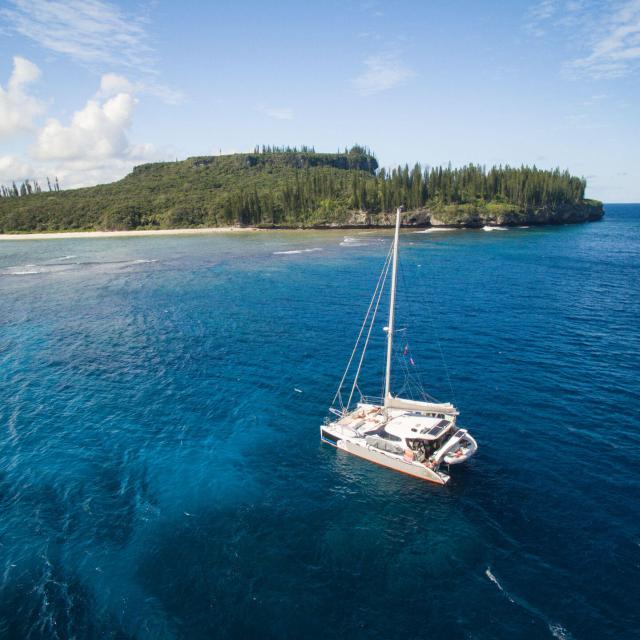 Catamaran in the islands of New Caledonia
Catamaran in the islands of New Caledonia Ouvéa, Loyalty Islands
Ouvéa, Loyalty IslandsPending customary agreements, it is advisable to anchor in front of the Mouli chiefdom or the gendarmerie in Fayaoué. Once there, enquire about making a customary gesture to the owner or tribal chief.
The Great South offers vast landscapes of red earth, mining scrub, and rivers. Safe anchorages between the capital and the South lagoon are found in Prony Bay, Port Boisé, and Île Ouen. This region is also known for humpback whale sightings between mid-July and mid-September.
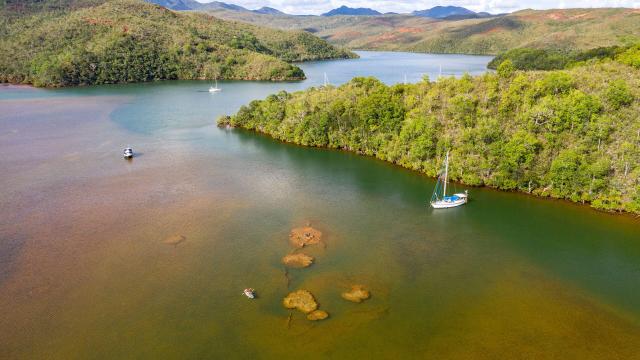 Baie Du Carenage Boucher Thomas 2030 04 23
Baie Du Carenage Boucher Thomas 2030 04 23 Boat trip along the West Coast, New Caledonia
Boat trip along the West Coast, New CaledoniaThe leeward West Coast features wide-open spaces with niaouli tree savannahs, mangroves, stockmen, cattle, and rodeos. Numerous safe anchorages allow you to enjoy wild bays and islets, including Ténia islet, Saint-Vincent Bay, Croissant Bay, and Koumac.
The windward East Coast offers a change of scenery and authenticity with Melanesian tribes and lush valleys. Sheltered anchorages along this coast, such as Hienghène or Port Bouquet, are ideal for stopovers.
 Marina and tourist office of Hienghène
Marina and tourist office of Hienghène Catamaran cruise in the North
Catamaran cruise in the NorthThe Grand Lagon Nord is a UNESCO World Heritage site, wild and exotic. It provides a sense of the end of the world, both on land and at sea. Anchorages like Chasseloup Bay, Bélep Island, Boat Pass, and Neba await your visit.
Departure formalities must be completed within 24 hours before departure, and by Friday at the latest for boats leaving the Territory over the weekend. The boat’s papers and passports should be presented to:
Vessels leaving Nouméa are no longer authorised to call on the Territory of New Caledonia, including the Isle of Pines and the Loyalty Islands.
The best time to sail in New Caledonia is during the cool season, from late April to mid-November, when trade winds prevail, allowing for pleasant sailing conditions. From December to April, the cyclone season makes sailing less favourable.
New Caledonia is equipped with well-appointed shipyards, and service providers are proficient in various fields. You can find a directory of service providers for repairs in your port of call booklet.
Noumea Yacht Services, located on the waterfront of the main port and marina facilities, offers comprehensive services for yachts, superyachts, and mega yachts. Their staff is fluent in English, French, and Spanish, providing services such as customs clearance, administrative formalities, caretaking, repairs, recruitment of onboard personnel, provisioning, organisation of activities and visits, on-site transfers, and transport services, among others.